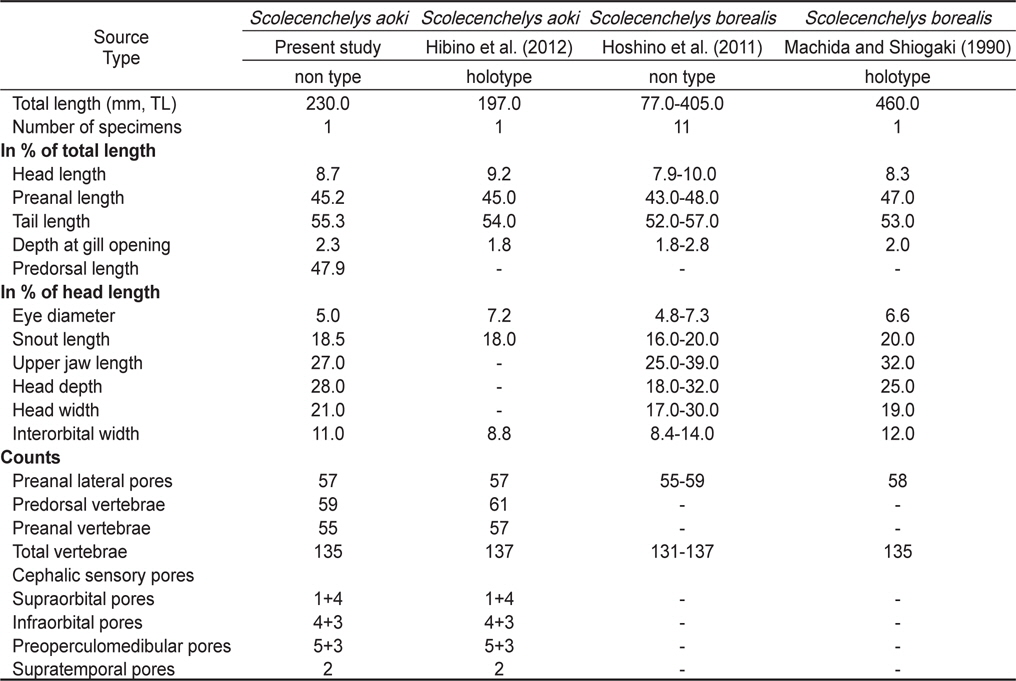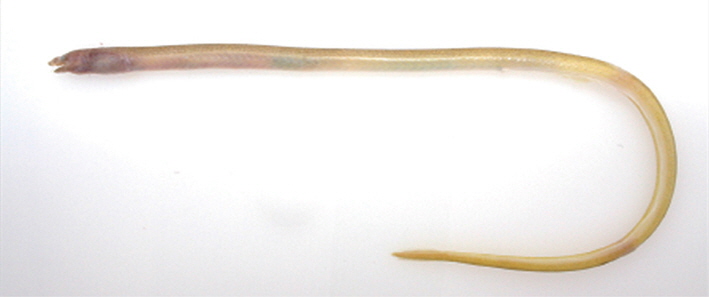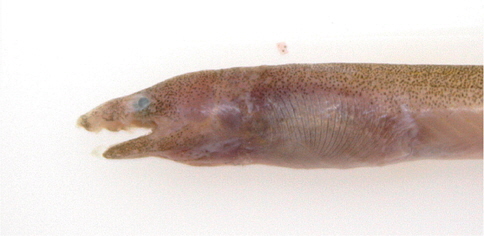바다뱀과(Ophichthidae) 어류에 속하는 가는물뱀속(신칭, Scolecenchelys) 어류에는 전세계적으로 21종이 알려져 있으며(Eschmeyer, 2013; Hibino et al., 2013), 국내에는 2종(Scolecenchelys borealis, Scolecenchelys sp.)의 엽상자어가 분자동정을 통해 최근 보고된 바 있다(Ji et al., 2012). 가는물뱀속 어류는 아열대 및 열대해역의 사니질에 서식하며(McCosker, 1977; Castle and McCosker, 1999), 눈이 위턱 중앙보다 뒤쪽에 위치하고, 전비공과 후비공 사이에 안하골공이 2개 있으며, 양턱에는 1-2열의 원뿔니를 가지는 특징을 보인다(Castle and McCosker, 1999). Castle and McCosker (1999)는 가는물뱀 속 어류의 분류학적 재검토에서 갯물뱀속(Muraenichthys) 5종 (M. borealis, M. gymnota, M. japonica, M. macroptera, M. okamurai)을 이빨, 후비공, 두부감각공수 등 형태특징에 의거 가는물뱀속으로 전속시켰으며, 많은 학자들이 이 분류체계를 따르고 있다(Hoshino et al., 2011; Hibino et al., 2012; Eschmeyer, 2013; Froese and Pauly, 2013). 이후, Hoshino et al. (2011, 2012)은 최근 S. borealis와 S. okamurai 2종의 형태를 면밀히 분석한 결과 S. aoki와 동일종임을 밝혔다. 따라서, 이미 국내 미기록종으로 보고된 동해물뱀(S. borealis)의 학명 재검토가 필요하다. 그러나, Ji et al. (2012)이 동해물뱀을 보고할 당시 엽상자어 1개체만을 사용하였기 때문에 성어 기반의 분류학적 재검토가 요구된다. 이러한 필요성에서 근해어업자원조사를 수행하던 중 2012년 10월 남해에서 동해물뱀으로 추정되는 성어 1개체가 채집되었기에 형태특징을 상세히 기술하고, 이를 참고자료(Machida and Shiogaki, 1990; Hoshino et al., 2011; Hibino et al., 2012)와 비교하여 국내 동해물뱀의 정확한 분류 위치를 구명하고자 한다. 나아가, 동해(독도)에서 채집된 동해물뱀 엽상자어(sensu Ji et al., 2012)의 DNA를 남해산 동해물뱀 성어의 것과 비교하여 동해물뱀 엽상자어의 정확한 분류 위치를 재검토하고자 한다.
2012년 10월 국립수산과학원 근해어업자원조사시 동해물뱀 1개체가 저층트롤에서 채집되었다. 채집 후 표본은 70% 알콜에 고정하였으며, 부경대학교(PKU)에 등록, 보관 하였다.
계수 및 계측은 McCosker (1977)의 방법을 따랐으며, 두부감각공 배열식은 McCosker et al. (1989)를 따랐다. 몸의 각 계측 부위는 Verniar caliper로 0.1 mm 단위까지 측정하였다. 척추골수는 Soft X-ray (HA-100; Hitex Co., Tokyo, Japan)를 이용하여 계수하였으며, 등지느러미 앞 척추골수-뒷지느러미 앞 척추골수-전체 척추골수(mean vertebral formular, MVF)로 나타내었다(Böhlke, 1982).
Genomic DNA는 Chelex resion 100 용액(Bio-rad)을 이용하여 근육에서 추출하였다. 미토콘드리아 DNA 12S rRNA 영역은 Ji and Kim (2010)의 Primer 정보 및 PCR 조건을 참고하여 증폭한 후, Direct sequencing 방법으로 염기서열을 결정하였다. 미토콘드리아 DNA 12S rRNA 염기서열은 BioEdit version 7의 ClustalW (Thompson et al., 1994)을 이용하여 정렬하였다. 비교 그룹으로 바다뱀과 어류 3종(Scolecenchelys breviceps, Muraenichthys gymnopterus, Pisodonophis sangjuensis), 외 집단으로 붕장어(Conger myriaster)를 선택하였다. 유전거리는 MEGA5 (Tamura et al., 2007)에서 Kimura-2-parameter 모델(Kimura, 1980)로 계산하였으며, 계통수는 MEGA5의 근린결합법(Neighbor joining method)을 이용하여 작성하였고, bootstrap은 10,000번 수행하였다.
Genus Scolecenchelys Ogilby, 1897 (국명신칭: 가는물뱀속) Scolecenchelys Ogilby, 1897: 246 (type species: Muraenichthys australis Macleay, 1881).
기재: 몸은 매우 가늘고 길다. 가슴지느러미는 없고, 새공은 수축되어 있다; 눈은 위턱의 중앙보다 후방에 있다; 양턱과 서골에는 원뿔니가 1-2열 있다; 후비공은 윗입술의 가장자리 안쪽에 있다; 새개골공은 3개이다; 전비공과 후비공 사이에 2개의 안하골공이 있다(Castle and McCosker, 1999).
Scolecenchelys aoki (Jordan and Snyder, 1901) (국명: 동해물뱀) (Fig. 1, Table 1)
Muraenichthys aoki Jordan and Snyder, 1901: 863 (type locality: Misaki, Japan); Hatooka, 2002: 216 (Japan).
Muraenichthys borealis Machida and Shiogaki, 1990: 1 (type locality: Mutsu Bay, Japan); Machida and Ohta, 1996; 79 (Japan); Hatooka, 2002; 216 (Japan).
Muraenichthys okamurai Machida and Othta, 1996: 77 (Mie Prefecture, Japan); Hatooka, 2002; 216 (Japan).
Scolecenchelys borealis: Castle and McCosker, 1999: 121 (revision); Hoshino et al., 2011: 184 (synonym); Ji et al., 2012: 417.
Scolecenchelys okamurai: Castle and McCosker, 1999: 121 (revision); Hoshino et al., 2011: 184 (synonym).
Scolecenchelys aoki: Hibino et al., 2012: 179 (synonym).
관찰재료: PKU 8546 (전장 230.0 mm), 한국 남해 (N33 °47′19″, E127°06′15″), 저층트롤, 채집수심 80 m, 채집자 김맹 진, 명세훈.
기재: 본 종의 계수 및 계측은 Table 1과 같다. 등지느러미 앞척추골수는 59개; 뒷지느러미 앞 척추골수는 55개; 전체 척추골수는 135개; 항문 앞 측선공수는 55개 이다.
몸은 원통형으로 매우 가늘고 길며, 후방으로 갈수록 더욱 가늘어 진다(Fig. 1). 항문은 몸의 중앙보다 다소 앞쪽에 위치한다. 주둥이는 뾰족하고, 위턱이 아래턱보다 앞쪽으로 돌출되어 있으며(Fig. 2), 위턱 선단부 이빨은 입을 닫았을 때 아래턱 밖으로 노출된다. 눈은 작고, 위턱의 중앙 보다 후방에 위치한다. 전비공은 관 모양으로 윗입술의 측면에 나 있고, 후비공은 구멍 모양으로 입술 가장자리의 안쪽에 위치한다. 새공은 작고 수축되어있으며, 몸의 측면 배쪽에 나 있다. 두부 감각공은 비교적 작은 데, 안상골공은 1+4개, 안하골공은 4+3개, 전새개하악골공은 5+3개, 상측두골공은 2개 이다. 양턱과 서골에는 2열의 작은 원뿔니가 비교적 뾰족한 모양으로 나 있고, 간상악골치는 둥근 모양을 하고 있다. 등지느러미는 항문보다 약간 뒤에서 시작하며, 가슴지느러미는 없다. 꼬리지느러미는 둥글며 짧다.
채색: 신선한 상태에서 몸의 등쪽은 갈색을 띠지만 배쪽은 희다. 머리는 짙은 갈색을 띠며, 새개부는 어둡다. 포르말린 고정후에는 몸의 등쪽이 좀더 짙은 갈색으로 바뀌며 배쪽은 그대로이다.
분포: 한국 남해 수심 80 m (본 연구; 성어), 동해 독도(Ji et al., 2012; 엽상자어), 일본 전 연안(Hatooka, 2002; Hibino et al., 2012).
부기: 한국 남해에서 채집된 성어 1개체는 가슴지느러미가 없는 점, 눈이 위턱의 중앙보다 후방에 위치하는 점, 양턱과 서골에 2열의 원뿔니를 가지는 점, 전비공과 후비공 사이에 2개의 안하골공을 가지는 점에 의거 가는물뱀속(Scolecenchelys)에 속한다(Castle and McCosker, 1999). 종 수준에서는 전체 척추골수가 135개인 점, 항문 앞 측선공수가 55개인 점, 등지느러미가 항문보다 약간 뒤에서 시작되는 특징에 의거 Scolecenchelys aoki로 동정된다(Table 1; Hatooka, 2002; Hibino et al., 2012). S. borealis 및 Scolecenchelys okamurai는 양턱 및 서골의 배열 (S. borealis는 2열 vs. S. okamurai는 1열) 및 간상악골치의 형태(S. borealis는 둥근모양 vs. S. okamurai는 준둥근모양) 등 미세한 차이를 보여 별종으로 간주되어 왔으나(Machida and Ohta, 1996; Hatooka, 2002), 최근 Hoshino et al. (2012)은 이들 2종의 모식표본과 다수의 비교 표본을 면밀히 조사한 결과 간상악골치의 모양과 이빨의 열수는 성장에 따른 변이, 즉 종내변이임을 확인하였고, 이에 근거하여 S. okamurai를 S. borealis의 동종이명으로 처리하였다(Hoshino et al., 2011). 이후, S. borealis 및 S. aoki는 상악치의 노출 유무(S. borealis는 입을 닫았을 때 상악치가 노출 vs. S. aoki는 입을 닫았을 때 보이지 않음)에서 구분되지만(Hatooka, 2002), Hibino et al. (2012)은 S. aoki와 S. borealis의 모식표본을 비교한 결과, 두종 모두 상악치가 노출되며, 형태적으로 차이가 없어 S. borealis를 S. aoki의 동종이명으로 정리하였다. 본 조사에서 채집된 1개체는 S. aoki 모식표본의 형태특징과 잘 일치하며, 양턱 및 서골의 이빨배열(본 개체는 2열 vs. 모식표본은 1-2열)에서만 약간 차이를 보였지만 이는 Hoshino et al. (2011)의 주장대로 종내 변이인 것으로 사료된다(Table 1; Hibino et al., 2012). Ji et al. (2012)이 보고한 동해물뱀 엽상자어는 본 조사에서 채집된 동해물뱀 성어와 전체 근절수(135개)에서 잘 일치하였으며 나아가 12S rRNA 886 base pair 염기서열을 비교한 결과에서도 100% 일치하여 동일종임을 확인할 수 있었다(Fig. 3; Table 2). 한국산 S. aoki는 일본산 S. aoki와 유전거리 0.2%로 거의 일치하였다(Fig. 3; Table 2). 따라서, Ji et al. (2012)이 독도에서 채집 한 동해물뱀 엽상자어의 학명은 S. borealis가 아닌 S. aoki로 변경하는 것이 타당하다. S. aoki는 근연종인 Scolecenchelys gymnota와 전체 척추골수 및 등지느러미 위치에서 유사하지만, 상악치의 노출(S. aoki는 노출 vs. S. gymnota는 보이지 않음) 및 전장에 대한 두장(S. aoki는 8.7% vs. S. gymnota는 9.6- 11.5%)에서 어느 정도 구분된다. 최근 일본에서 신종으로 보고된 Scolecenchelys fuscogularis와 비교하면, 항문 앞 측선공수(S. aoki는 55개 vs. S. fuscogularis는 63개), 전체 척추골수(S. aoki는 135개 vs. S. fuscogularis는 146-149개)에서 잘 구분된다(Hibino et al., 2013).










